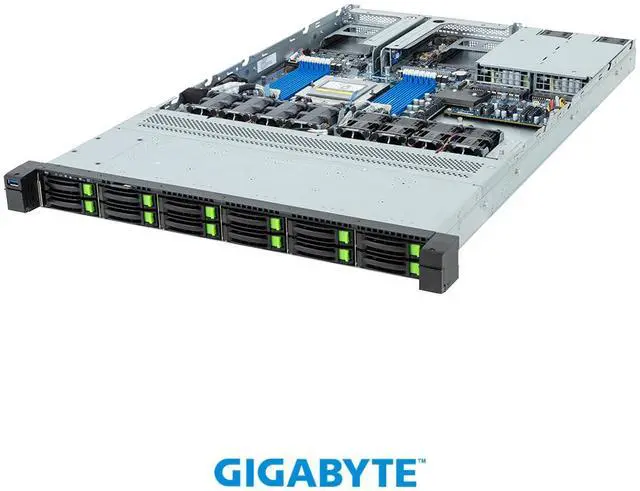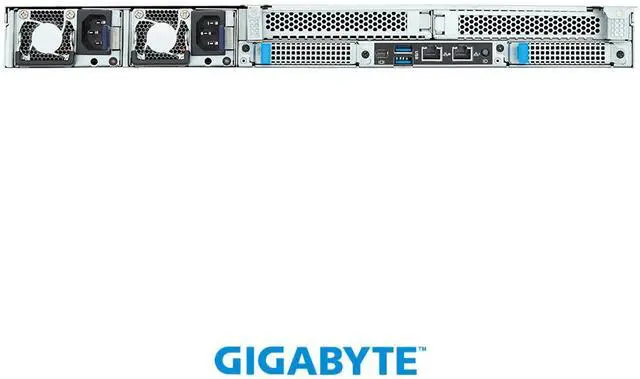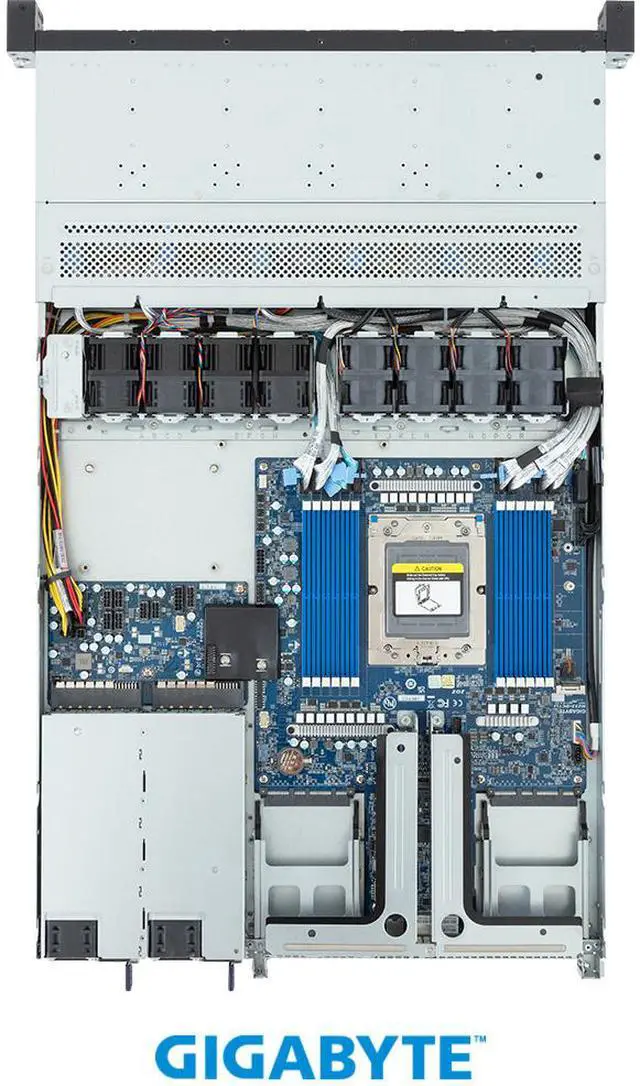
New AMD EPYC Family of Processors - Same Great SP5 Platform
The SP5 socket has reached its pinnacle form with 5th Generation AMD EPYC processors. The same successful platform that was shared by AMD EPYC 9004 & 8004 series processors is now the same one for AMD EPYC 9005 series processors. With up to 192 cores, increased frequencies and cache, this top tier performance platform targets general purpose, cloud native, and technical computing. Building on the advantages of the EPYC 9004 series, the new EPYC 9005 series adopts the 3nm process with AMD Zen5 and Zen5c core architecture, excelling in both energy efficiency and cost optimization. GIGABYTE has already prepared for this new processor with new servers and updates to existing products for 4th Gen AMD EPYC processors.

3nm architecture
Increased transistor density alongside a reduction in power consumption
Up to 192CPU cores
Dedicated Zen 5 & Zen 5c cores increase compute density
Up to 512MBL3 cache
An L3 cache increase helps to reduce latency in data-intensive operations
64GB HBM**
High bandwidth in-package memory massively speeds up data-intensive workloads
12 channels
Memory capacity up to 9TB in a 2 DIMM per channel configuration
Up to 160PCIe lanes
Dual socket configuration adds a significant amount of I/O connectivity
CXL 2.0support
Disaggregated compute architecture possible via Compute Express Link
* AMD EPYC 9005 Series processors require OEM enablement and a BIOS update from your server or motherboard manufacturer if used with a motherboard designed for the SP5 socketed AMD EPYC 9004 Series processors. Contact your system manufacturer prior to purchase to determine compatibility.
** CXL Type 1&2 devices and PCIe link encryption support dependent upon ecosystem readiness; type 2 PoC only.

Servers and motherboards by GIGABYTE are tested to ensure peak performance for demanding workloads while supporting the latest GPU and CXL technology.

With 192 CPU cores per socket, GIGABYTEs 4-node servers support up to 1,536 CPU cores, allowing a far greater number of concurrent tasks to be done.

Keeping pace with the challenges for next gen technology, well designed GIGABYTE boards provide users the signal integrity for fast PCIe 5.0 speeds.

AMD and GIGABYTE have maintained a healthy relationship that values shared knowledge and open communication in order to launch products in tandem.

Our broad portfolio of products tailored to applications allow customers to only select server features they require while doing so at a lower TCO.

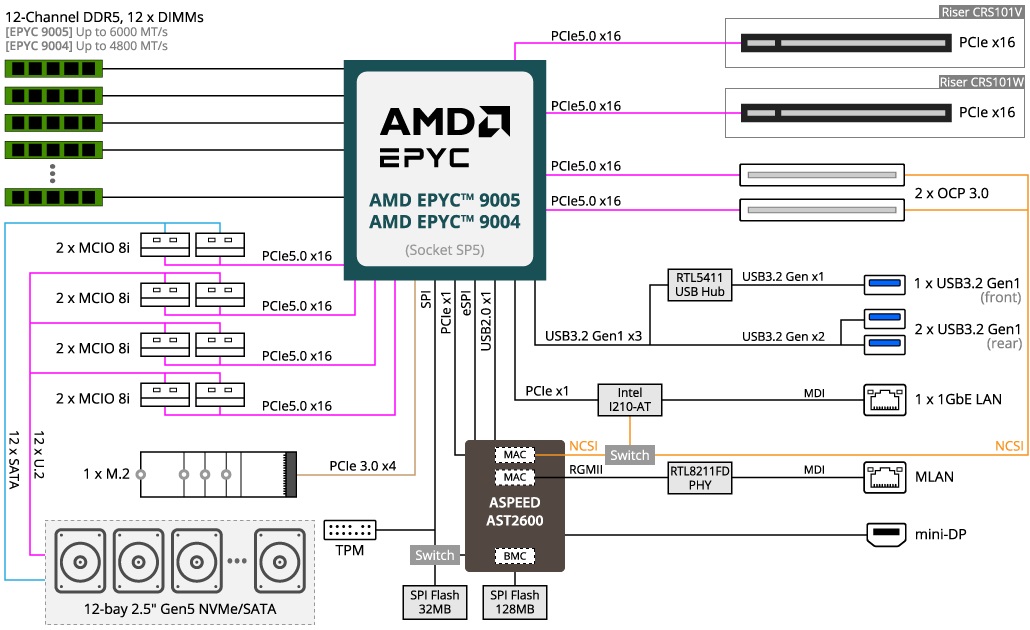

For hardware-based authentication, the passwords, encryption keys, and digital certificates are stored in a TPM module to prevent unwanted users from gaining access to your data. GIGABYTE TPM modules come in either a Serial Peripheral Interface or Low Pin Count bus.
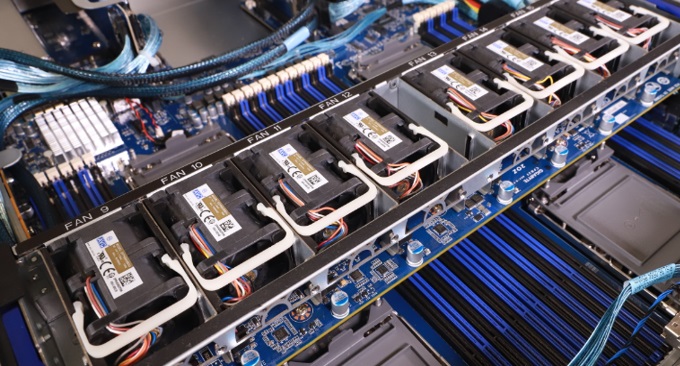
GIGABYTE servers are enabled with Automatic Fan Speed Control to achieve the best cooling and power efficiency. Individual fan speeds will be automatically adjusted according to temperature sensors strategically placed in the servers.

To take advantage of the fact that a PSU will run at greater power efficiency with a higher load, GIGABYTE has introduced a power management feature called Cold Redundancy for servers with N+1 power supplies. When the total system load falls lower than 40%, the system will automatically place one PSU into standby mode, resulting in a 10% improvement in efficiency.

Clipping mechanism secures the drive in place. Install or replace a new drive in seconds.

GIGABYTE offers servers that feature an onboard OCP NIC 3.0 slot for the next generation of add on cards. Advantages of this new type include:
- Easy Serviceability: Simply slot in or pull out the card, without opening the server or using tools
- Improved thermal design: Horizontal position and optimal heat sink design allow for air cooling to eliminate the heat efficiently

Being a member of key software alliance partner programs enables GIGABYTE to rapidly develop and validate joint solutions, enabling our customers to modernize their data centers and implement IT infrastructure and application services with speed, agility, and cost optimization.

To prevent server downtime and data loss as a result of loss of AC power, GIGABYTE implements SmaRT in all our server platforms. When such an event occurs, the system will throttle while maintaining availability and reducing power load. Capacitors within the power supply can supply power for 10-20ms, which is enough time to transition to a backup power source for continued operation.

SCMP is a GIGABYTE patented feature which is deployed in servers with non-fully redundant PSU design. With SCMP, in the event of faulty PSU or overheated system, the system will force the CPU into an ultra-low power mode that reduces the power load, which prevents the system from unexpected shutdown and avoids component damage or data loss.

If the ROM that stores the BMC and BIOS fails to boot, the system will reboot with the backup BMC and/or BIOS replacing the primary. Once the primary BMC is updated, the ROM of the backup BMC will automatically update the backup through synchronization. For the BIOS, it can be updated based on user's choice of firmware version.

For management and maintenance of a server or a small cluster, users can use the GIGABYTE Management Console, which is pre-installed on each server. Once the servers are running, IT staff can perform real-time health monitoring and management on each server through the browser-based graphical user interface. In addition, the GIGABYTE Management Console also provides:
- Support for standard IPMI specifications that allows users to integrate services into a single platform through an open interface
- Automatic event recording, which can record system behavior 30 seconds before an event occurs, making it easier to determine subsequent actions
- Integrate SAS/SATA/NVMe devices and RAID controller firmware into GIGABYTE Management Console to monitor and control Broadcom MegaRAID adapters.
GIGABYTE Server Management (GSM)
GSM is a software suite that can manage clusters of servers simultaneously over the internet. GSM includes a complete range of system management functions that includes the following utilities:
- GSM Server: A software program that provides real-time, remote control using a graphical user interface through an administrator's computer or through a server in the cluster. The software allows ease of maintenance for large clusters of servers.
- GSM CLI: A command-line interface for monitoring and managing remotely.
- GSM Agent: A software program installed on each GIGABYTE server node that retrieves information from each system and devices through the OS, and this software integrates with GSM Server or GSM CLI.
- GSM Mobile: A mobile app for both Android and iOS that provides admins with real-time system information.
- GSM Plugin: An application program interface that allows users to use VMware vCenter for real-time monitoring and management of server clusters.


* The entire materials provided herein are for reference only. GIGABYTE reserves the right to modify or revise the content at anytime without prior notice.
* Advertised performance is based on maximum theoretical interface values from respective Chipset vendors or organization who defined the interface specification. Actual performance may vary by system configuration.
* All trademarks and logos are the properties of their respective holders.
* Due to standard PC architecture, a certain amount of memory is reserved for system usage and therefore the actual memory size is less than the stated amount.



